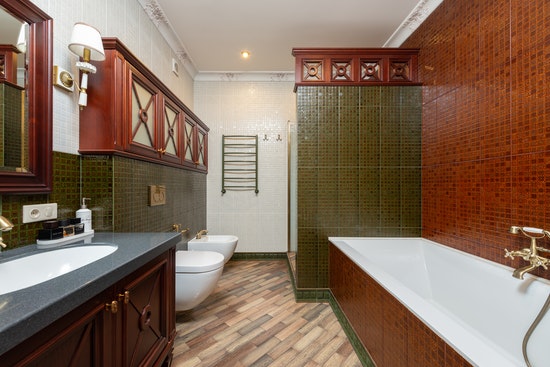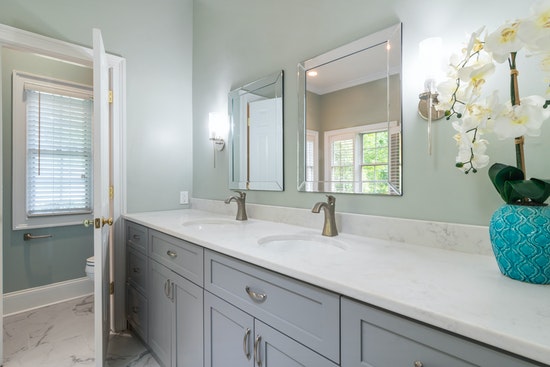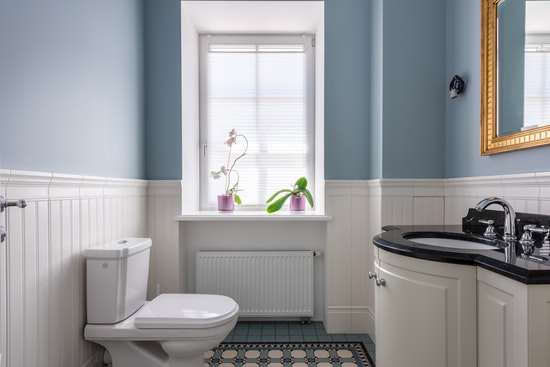The process of painting bathroom vanity storage and cabinets could be an arduous task, especially if you are aiming for a certain aesthetic but ultimately coming out awkward after putting in the work. However, the answer to the solution is really just choosing the right color to blend in the interior design of the bathroom vanity decor.
If you’re not sure what accents work with and which vanity painting would perfectly blend with your bathroom style, then you’d be glad to know that the article I have prepared for today will especially cover the subject matter.
In today’s article, I will provide you with the best paints, the tools needed, and simple steps on how you can properly paint your bathroom vanities. I’ll also share my insights on the topic of painting bathroom cabinets color ideas along the way to give you a good sense of the right palette combination.
- Which Kind of Paint to Choose for Painting Bathroom Vanity?
- Tools You Need
- Vanity Painting Steps
- Takeaway

Which Kind of Paint to Choose for Painting Bathroom Vanity?
First and foremost, we have to discuss the best paint for bathroom cabinets or storage and bathroom vanity colors. Now, this is an important consideration to take on because the color and the type of paint for bathroom determine the reliability of the work that has been done aside from the apparent overall aesthetics.
Before we go any further, below are some of the best colors to consider for painting bathroom cabinets:
- Chelsea Gray – Benjamin Moore HC-168
- Evergreen Fog – Sherwin Williams 9130
- Mega Greige – Sherwin Williams 7031
- Navy Blue – Benjamin Moore City Shadow CSP-60
- Black – Benjamin Moore 2132-10
Now, below are some of the Paint solutions for painting bathroom vanity and storage:
Alkyd Based Paint
A paint solution that is alkyd based refers to the enamel finish with a similar consistency to oil paints. This type of paint is perfectly suited for wood or metal surfaces. As a result, it emits a semi-gloss but is super hard and tolerant to cracking and scratches.
For better results, opt for water-based alkyd paint for a more classical accent that perfectly fits with the vanity theme of the bathroom.
Satin Latex-Based Paint
Satin is a type of paint that could either be oil or latex-based. But no matter what type you choose, both of them do not emit a high gloss finish. However, it still has reflective properties but is not as shiny as alkyd paint. This kind of paint emits a chic and elegant style that blends well with light colors, and it attracts more natural in an open or wide bathroom area.
Matte Based Paint
If a glossy finish isn’t your thing, you can opt for a matte-based paint that will give you no shine at all. Instead, it provides a fine and solid texture that is appealing in some other way. However, the only disadvantage of this compound is that the dryness of the after paint does accumulate dust over time.
But overall, the matte base paint is your best option if you are looking for a finish that emits a vintage and antique-esque appearance.

Tools You Need
The following are the simple tools you will need to help you how to paint bathroom cabinets like a pro:
- Paint(s)
- Paint tray and stir sticks
- Putty Knife
- Microfiber paint rollers
- Synthetic fiber paint brush
- Painters tape
- Primer
- Screwdriver or cordless drill
- De-glosser
- Drop cloth
- Bucket
- Rubber gloves
- Sponge
- Protective glasses
- Sandpaper – 120 to 220 grit
- Wood filler
- Tack cloth
Vanity Painting Steps
Below are the necessary steps you have to take in painting bathroom vanity:
First Step: Uninstall Attachments
Before you begin with the painting process, you have to uninstall or unmount the hardware attached to the vanity, such as doors, cabinets, or mirrors. In addition, you also have to remove the hinges and doors by using a screwdriver. If you are unable to properly dismantle them, you may accidentally paint the hinges and handles. After you have removed them, ensure that you have labeled them to make it a lot easier for you to assemble them after the paint has dried up.
Second Step: Clean and Sand the Furniture
Afterward, you have to clean and sand the cabinet first before you apply paint to them. Clean the cabinet and wipe off all accumulated dust, dirt, stains, and grease using a mild cleaning solution. Wipe them off and leave them dry before you use sandpaper to prepare them for the primer.
Use a 120 to 220 sandpaper to smoothen the surface of the cabinets. And then, clean the excess wood dust using a damp rag. If your vanity is in good shape, then you can use a de-glosser instead of sandpaper which basically removes the gloss and old paint from the cabinet.
Third Step: Apply the Primer Solution
Prepare the primer solution and double-check if the vanity is properly sanded and cleaned for the last time. Place a cover cloth beneath the vanity before applying the primer. Use either a paintbrush or roller to coat the cabinet with primer.
If your cabinet has intricate details or engravings, then you may have to use a tapered brush to accommodate the contours of the vanity. You have to remember that a regular paint brush and rollers will only work perfectly fine on flat surfaces. Afterward, let the primer dry before moving on to painting bathroom vanity.
Fourth Step: Paint the Vanity Cabinet
Most commercialized paints require consumers to use them within the 24-hour window once they have mixed them. This is to ensure that the coverage of the paints is even and does not bubble. Once you have reached the mixture consistency you are looking for, load the paint onto the paint tray.
Use either a roller or paint brush to work with the surface of the cabinets. You also have to prepare a second coat of paint to strengthen the bonds of the compound. And then leave it to dry.
Fifth Step: Reassemble
After you are sure that the paint has all dried out, gather all the items you have dismantled and start reassembling them. Afterward, you can immediately notice the painting bathroom vanity before and after-effects.

Takeaway
Repurposing your vanity starts with the paint job. Although the process is relatively straightforward, it would take quite some time and patience to complete the entire work, and you have to follow the instructions on painting the bathroom vanity I’ve relayed to ensure the quality of the job.
Frequently Asked Questions about Painting Bathroom Vanity
Now, below are some of the common concerns about painting bathroom vanity:
The best types of paint you can use for your wooden vanities are as follows:
Alkyd Based Paint
Satin Latex-Based Paint
Matte Based Paint
Since bathroom vanities are made of wood, the recommended paint finish for this type of furniture is a semi-gloss surface. This characteristic gives the vanity the classical yet chic vibe you are aiming for.
0 Comments for “Painting Bathroom Vanity and Cabinets Easily”